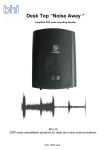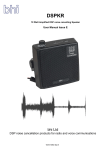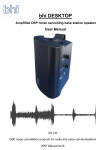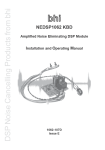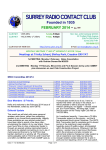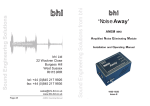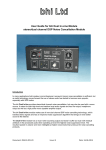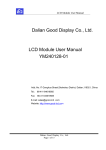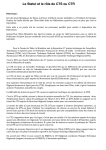Download DTNA Noise Away manual ISSD
Transcript
DTNA Noise Away Amplified DSP noise cancelling Speaker User Manual bhi Ltd DSP noise cancellation products for radio and voice communications 1067-105D iss D Important Information: Copyright This publication, including all photographs and illustrations is protected under international copyright laws, with all rights reserved. Neither this manual, nor any of the material within, may be copied or reproduced without the written consent of bhi Ltd. Disclaimer The information in this document is subject to change without notice. bhi Ltd makes no representations or warranties with respect to the contents hereof and specifically disclaims any implied warranties of merchantability or fitness for any particular purpose. Furthermore, bhi Ltd reserves the right to revise this publication and to make changes from time to time in the content hereof without obligation of bhi Ltd to notify any person of such revision or changes. Table of Contents 1. Packing List ……………………………………………………………………..page 2 2. Introduction……………………………………………………………………..page 3 3. DSP noise cancellation………………………………………………………...page 3 4. Installation………………………………………………………………………..page 4 5. Speaker operation………………………………………………………………page 4 6. DSP function button.……………………………………………………….…..page 5 7. Setup mode………………………………………………………………………page 5 8. Demonstration modes…………………………………………………………..page 6 9. Noise reduction levels…………………………………………………………..page 6 10. Specification………………………………………………………………….….page 7 11. Troubleshooting/FAQ’s…...…………………………………………………....page 7 12. bhi Support……………………………………………………………………...page 7 1. Packing List The DTNA Noise Away is shipped with the following: • • • • • DTNA noise cancelling speaker 3.5mm audio lead Speaker mounting bracket Fused DC power lead 1030-FPL Operating manual Page 2 2. Introduction The bhi DTNA Noise Away amplified DSP noise cancelling speaker greatly improves the clarity and intelligibility of speech in radio and voice communication systems. It is suitable for use in base station applications where background noise and interference mean that you cannot clearly hear what is being said. The speaker will enable the user to listen and concentrate “stress-free”. Suitable applications where the speaker will be of great benefit are: Amateur radio, two-way radios, HF radios, marine communications, scanners, taxi base stations etc. The DTNA Noise Away incorporates unique DSP technology to remove unwanted background noise and interference from speech and has up to 8 DSP filter levels, allowing the user to optimise for their level of noise and interference. The speaker simply connects into the extension speaker socket or headphone socket of the radio communications equipment. The DTNA Noise Away comprises a 4” bass driver and a 1” tweeter unit, and an amplified DSP noise cancelling unit capable of producing up to 2.5Watts RMS audio power. The unit requires an audio input signal of between 80 and 500mW level and a DC supply of between 12 and 18 Volts (300mA). The unit is supplied with a 1.2 metre audio cable with a moulded 3.5mm jack plug for the audio input, as well as a 2.1mm fused DC power lead and user manual. The bhi DTNA Noise Away is easy to set up and its functions are microprocessor controlled, enabling simple operation via two the pushbuttons on the front of the speaker grille: Power on/off audio bypass and DSP filter on/off and level select. The last selected settings remaining in the memory when the unit is switched off. Note: The speaker is designed for speech signals and is not really suitable for music. 3. DSP Noise cancellation. The bhi DSP processes the incoming signal and differentiates the speech from the noise. The unwanted noise and interference is then attenuated to leave only the speech. The following diagrams are taken from actual audio signals and illustrate how the signal is being processed. Original signal. Speech with a lot of background noise Page 3 Processed speech. Speech with reduced noise 4. Installation The speaker is supplied with a mounting bracket that can be left on in case of permanent fixing, or removed altogether depending on personal choice. Connect the 3.5mm mono plug lead supplied to the extension speaker socket of your radio, and then connect the black and red terminals at the other end of the audio lead to the corresponding red and black screw terminals on the rear of the speaker. Connect the fused DC power lead supplied to a power supply capable of providing 12 18VDC @ 300mA. (The centre pin of the 2.1mm power connector is positive and the lead with the white stripe is positive), or use a suitable mains plug-in 12V DC power supply (300mA). 5. Speaker Operation Once installed and connected, apply power to both the audio source and the speaker. Press the power/bypass switch located in the speaker front grill. When power is applied to the speaker, the LED will flash and turn red or orange depending on whether 4 or 8 levels of noise cancelling have been selected. The power button switches the module on and off. When the module is switched off, the audio bypasses the module, so the circuit will behave as if the module isn’t present and the unit becomes a passive extension speaker. Note: If the power is on and the DSP is switched off, the audio still passes through the DSP, but without any signal processing. 6. DSP Function button This button is used to set the following: • DSP filter on/off • DSP level select • 8 levels of noise cancellation select • Demonstration mode select DSP mode 4 Levels 8 Levels OFF RED ORANGE ON GREEN GREEN Table 1. LED mode indication. Page 4 7. Setup mode To change the number of DSP levels or listen to the demonstration modes, it is necessary to put the module into the setup mode. To do this, ensure the module is switched off. Press and hold the DSP level button. Turn on the module and a 2 tone beep will be heard indicating that the module is in the set up mode. Releasing the button after the first 2 tone beep will enter demonstration mode 1. Releasing after the second 2 tone beep will enter demonstration mode 2. Releasing after the third 2 tone beep will set the unit to level 2 in the 4 level mode. After the fourth beep, keep the button depressed. 4 beeps will indicate 4 level mode and 8 beeps 8 levels. Release the button to select the desired level mode. The module will return to normal operation after this. The colour of the LED will indicate the mode of operation. 8. Noise reduction levels. 4 or 8 levels of noise reduction are available. The amount of noise and tone reduction is shown in the table below. Level (4) 1 2 3 4 Level (8) Tone Reduction White Noise Reduction 1 4dB 9dB 2 5dB 11dB 3 6dB 13dB 4 8dB 15dB 5 16dB 17dB 6 21dB 20dB 7 25dB 24dB 8 65dB 35dB Table 2. Tone and noise reduction levels. The column marked level (4) shows the noise and tone reduction when operating the module with 4 levels, and the level (8) column shows it for 8 levels. With the DSP noise cancelling switched on (green LED), holding down the function button will continuously change the DSP level until the desired level is reached. Release the button. The module will retain this level until it is changed. Page 5 9. Demonstration modes. Demonstration mode 1 The module switches the noise cancellation on for 1.5 seconds, then off for 1.5 seconds. It will then move to the next level and repeat the process. This mode is particularly effective at demonstrating the different DSP levels. A lternatively pass a clean audio signal through the module to see hear how little the DSP alters the speech. Demonstration mode 2 The module switches the noise cancellation on for 3 seconds then off for 3 seconds. This is a good demonstration of the before and after effects of the noise cancellation. Note: To exit the demonstration modes hold down the DSP button until a 2 tone beep is heard. Start Start Noise cancellation On Noise cancellation On Wait 3 Seconds Wait 1.5 Seconds Noise cancellation off Noise cancellation off Wait 3 Seconds Increase DSP noise cancellation level No DSP button pressed? Yes 2 tone beep No Highest Level? Yes Normal operation Normal operation Page 6 10. DTNA Noise Away Specifications DC Power DC input voltage Current consumption 12 to 18 Volts DC 300mA Audio Input Impedance Minimum input level Maximum i/p audio Terminated with approximately 8 Ohm load 50 mV – 500mV 5 Watt Audio output Output load Audio bandwidth Controls Indications Connections 2.5W 8ohm 50 – 4.3KHz Power bypass/Function button Power ON/ FUNCTION 2.1mm DC power jack (Centre +ve) 3.5 mm mono plug lead 2m long 4mm binding posts DSP noise cancelling Number of levels Indication Noise reduction Tone reduction 4 or 8 filter levels (selectable) Visual and audio indication of filter level 9 – 35dB 4 – 65 dB Physical dimensions Weight Dimensions 1.65Kg 200(H) x 150(D) x 160(W)mm 11. Troubleshooting/FAQs Speaker doesn’t work at all, no sound from the speaker: • Check that the power connector on your power supply is suitable for the power socket on the speaker (2.1mm, centre positive). • Check that you have switched your radio communication equipment on and that you have a signal for the speaker to process. To verify this, remove the audio connector from the external speaker socket on your equipment. • Check that the Desk Top “Noise Away” Power LED is on. The speaker works but the noise cancellation doesn’t appear to improve the audio quality of the signal: • Check that the filter is switched on (green LED). • Increase the filter level to see if this makes a difference. • Increase the volume on the audio source. 4. Troubleshooting/FAQs The volume from the speaker is low and cannot be increased: • The speaker is designed to work with the external speaker sockets of radio communications equipment, and although it will work with some earphone and headphone sockets, there may be occasions where the signal output from these Page 7 types of output sockets is not enough for the speaker electronics to process the signal effectively. bhi have another product that will work with these levels of signal, the NEIM1031MKII (DSP Noise Eliminating In-line Module). Please contact bhi for more information. See end of operating manual for contact information. Sometimes there is a short delay before the noise cancellation is active: • This is due to the time the DSP takes to start processing the signals. This gives you the opportunity to check that the DSP is not taking out any detail from the signal. Sometimes I can hear a processing sound in the speakers when no signal is present: • This is caused by the DSP processor and is normal. When a signal is applied you should not be able to hear this in the speaker. 12. bhi support Every DTNA Noise Away noise eliminating speaker comes with a 12 month guarantee against defective materials and workmanship. If you do have a problem then please refer to the troubleshooting guide (section 11). If you have not resolved your problem then please contact us. Before you make your call please have the following information to hand: 1. Your serial number (found on the back of the unit). 2. Details of when and where you purchased the unit. See our website for FAQs for answers to other common questions, otherwise most queries can be resolved over the telephone. If not we will arrange with you to have your unit sent back to us for analysis, repair or replacement (if within 12 months from date of purchase, if outside the guarantee period an estimate of the cost of repair will be given). For contact details please refer to the back cover of this manual. If you have any suggestions for improvements please complete and return the customer feedback form. Note: Opening the case should only be done to make audio adjustments as described at the end of this manual. This may void any warranty if the correct procedure is not carried out. Weee Statement for correct disposal of this product (Applicable in the European Union and other European countries with separate collection systems). This marking shown on the product or its literature, indicates that it should not be disposed of with other household wastes at the end of its working life. To prevent possible harm to the environment or human health from uncontrolled waste disposal, please separate this from other types of wastes and recycle it responsibly to promote the sustainable reuse of material resources. Household users should contact either the retailer where they purchased this product, or their local government office, for details of where and how they can take this item for environmentally safe recycling. Business users should contact their supplier and check the terms and conditions of the purchase contract. This product should not be mixed with other commercial wastes for disposal. Page 8 bhi DTNA Noise Away Speaker Dis-Assembly and Audio Adjustment Procedure The Speaker is set up to operate with a wide audio input level range. But under certain conditions, like using the speaker with a shortwave receiver, you may need to adjust the audio settings of the amplified DSP module to obtain optimum performance. Note: This procedure should only be carried out by people with the relevant skills. 1. Using a very fine flat blade screwdriver of something similar like a letter opener, carefully prise the grille off by pushing the tool into one of the corners where the speaker grille touches the speaker housing. Carefully lever the grille up and then pull the grille out from the from of the speaker front. 2. Carefully pull the grille to one side to expose the 6 screw holes. Using a suitable Philips or pozi screwdriver remove the screws (can be 4 or 6 screws). 3. Remove the front half of the speaker and remove the baffle material and lay to one side so that the circuit board is accessible. 4. Connect your radio to the speaker, connect the power to the speaker and switch the radio on. With the speaker in bypass mode (power off), turn the radio volume to your normal audio level. Now switch the speaker on. 5. Look at the red LED near the large electrolytic cap and relay (see schematic below). If this is flashing red then you need to adjust the pot P2 counter clockwise so that there is the odd flash of red or none at all from the LED. 6. If the LED is not flashing then you need to adjust P2 clockwise until the LED flashes then back it off and adjust as in 5. 7. If you wish to increase the audio output you can adjust the potentiometer P1 clockwise to give you the desired level. Please be aware that if you increase this level, when you turn the speaker off it will revert to bypass and the audio output will be lower. If you turn the volume up on your radio to compensate and then switch the speaker back on, the volume may be too loud for you. 8. Once you are happy with all the audio levels and audio quality, re-assemble the speaker carefully (remember to put the white baffle material back in the speaker prior to fitting the screws). Page 9 bhi Ltd PO Box 318 Burgess Hill West Sussex RH15 9NR England Telephone: + 44 (0)845 217 9926 Fax: + 44 (0)845 217 9936 Email: [email protected] Web: www.bhi-ltd.com Page 10 1072-105D iss D










